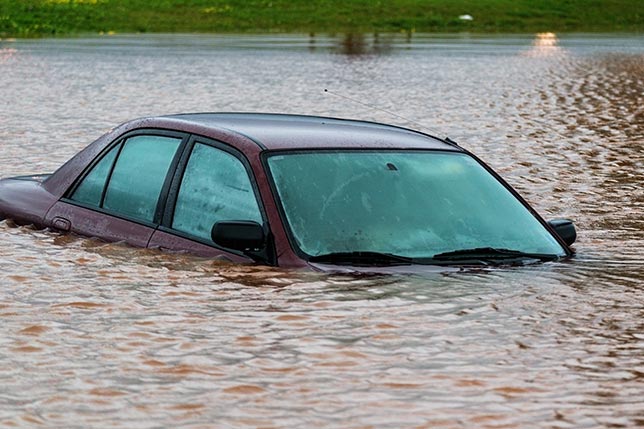During a flood

Floods are one of most common weather dangers in the U.S. and cause millions of dollars of damage each year. If you find yourself caught in a flood, the most important thing you can do is make sure you and your family are safe.
If flooding is happening
If a flood is threatening your home or your car, listen for information and instructions on the television or radio. If a flash flood is occurring and you are at high-risk, grab your emergency kit (with drinking water, non-perishable food, first-aid materials, blankets, a battery-powered radio, a flashlight and extra batteries) and your family and immediately move to higher ground. Don't wait for evacuation instructions during a flash flood.
If a flood is likely but hasn't yet occurred
If you have time before a flood affects your home and a flash flood isn't a threat, you should activate your flood plan. Start with moving your valuables to upper floors and securing your outdoor belongings. Turn off utilities at the main valves. Disconnect any electrical appliances, but not if you are wet or standing in water. Listen to the television or radio and follow any instructions.
You should be ready to evacuate. Close and lock your doors and windows. Have your emergency kit handy, as well as you car keys, a charged cell phone, credit cards and insurance information.
During an evacuation
Once you leave your house, make sure you are aware of the dangers you could encounter while trying to get to higher ground. Here are some rules:
Do not walk through moving water.
You can easily fall in as little as six inches of moving water. If you have to walk through water, find a place where the water is stagnant. Use a stick to check how firm the ground is in front of you.Do not drive in flooded areas.
It's easy to misjudge the depth of a flood, but just a little water can pose a big risk to your vehicle. Six inches of water is enough to reach the bottom of most passenger vehicles and cause a loss of control. A foot of water will float most vehicles and two feet of rushing water is powerful enough to carry away sport utility vehicles (SUVs) and pick-up trucks.Watch the roads.
Roads may have cracked or been washed away in a flood. Pay attention the condition of the streets you're driving.If water rises around your car, react quickly if it's safe.
Abandon the vehicle and move to higher ground if possible.- If you come in contact with floodwater, wash your hands with soap and clean water as soon as possible, because you don't know what chemicals may be mixed in the floodwater.
Again, the most important thing for you to do in a flood is to make sure you and your family are safe. When it comes to minimizing damage and increasing safety during a flood, it is beneficial to prepare. Most homeowners policies do not provide coverage for flood. Check your policy's Declarations Page to see if flood coverage is listed. You can purchase a flood insurance policy from the National Flood Insurance Program (NFIP) issued by Foremost through your local agent, as long as your community participates in the NFIP. Click here to learn more. Note that while you can purchase flood insurance at any time, there is a 30-day waiting period after you've applied and paid the premium before your policy is effective.





